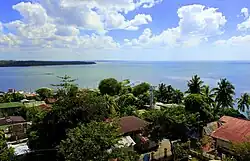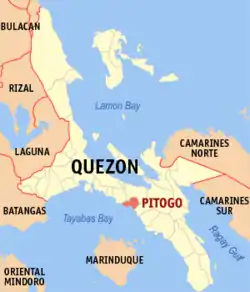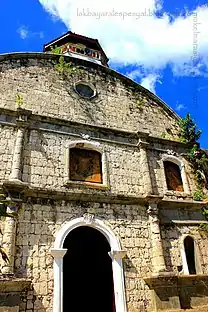Pitogo | |
|---|---|
| Municipality of Pitogo | |
 Downtown area | |
 Flag | |
 Map of Quezon with Pitogo highlighted | |
OpenStreetMap | |
.svg.png.webp) Pitogo Location within the Philippines | |
| Coordinates: 13°47′06″N 122°05′17″E / 13.785°N 122.0881°E | |
| Country | Philippines |
| Region | Calabarzon |
| Province | Quezon |
| District | 3rd district |
| Founded | January 25, 1681 |
| Barangays | 39 (see Barangays) |
| Government | |
| • Type | Sangguniang Bayan |
| • Mayor | Dexter L. Sayat |
| • Vice Mayor | Paul Timothy C. Villaflor |
| • Representative | Reynante U. Arrogancia |
| • Municipal Council | Members |
| • Electorate | 16,756 voters (2022) |
| Area | |
| • Total | 73.39 km2 (28.34 sq mi) |
| Elevation | 13 m (43 ft) |
| Highest elevation | 87 m (285 ft) |
| Lowest elevation | 0 m (0 ft) |
| Population (2020 census)[3] | |
| • Total | 22,798 |
| • Density | 310/km2 (800/sq mi) |
| • Households | 5,599 |
| Demonym | Pitogohin |
| Economy | |
| • Income class | 4th municipal income class |
| • Poverty incidence | 8.67 |
| • Revenue | ₱ 107 million (2020) |
| • Assets | ₱ 237 million (2020) |
| • Expenditure | ₱ 18.23 million (2020) |
| • Liabilities | ₱ 57.06 million (2020) |
| Service provider | |
| • Electricity | Quezon 1 Electric Cooperative (QUEZELCO 1) |
| Time zone | UTC+8 (PST) |
| ZIP code | 4308 |
| PSGC | |
| IDD : area code | +63 (0)42 |
| Native languages | Tagalog |
Pitogo, officially the Municipality of Pitogo (Tagalog: Bayan ng Pitogo), is a 4th class municipality in the province of Quezon, Philippines. According to the 2020 census, it has a population of 22,798 people.[3]
History

The fact that Pitogo is built on a promontory of rolling hills has a great rationale behind. Historical records show that this site was selected by the town's founders in 1766 because its lofty elevation provided them with good look out points for the marauding vintas of Muslim pirates who were then threatening the safety of the natives.
In 1754, a band of Christian settlers led by Juan Mauricio founded the town farther inland, a few miles up the Mayubok River, (now Pinagbayanan), to be safe from Moro depredations. But despite this precaution, the Moros came and raided the town. They came along the coastal town of Kalilayan (Tayabas).
Two years later, in 1756, Alejo Bautista became the next ruler. Again, the Moros remembering the place, visited Mayubok, burned the settlement and killed many of its inhabitants. Due to so much fright, the people placed the biggest church bell in a banca but the banca capsized at Aasnan. Expert divers tried to recover the historic bell but their toil remained futile and all in vain.
The survivors built another settlement in 1760 along the banks of Cawayanin River under Bernabe Rafael. Likewise, this community was destroyed by the Moros. St. Paul (the patron saint) was lost. He was found in a nearby barrio. The people stayed for a short time in the said barrio naming it “Adia” meaning safety.
In 1766, Buenaventura Salvador selected a well-located hill, the Maaliw Hill where few fishing huts could be found. The place was chosen because from its summit, where a native watchtower (Castillo) could be found, the approaching Moro Vintas could easily be detected while still afar.
The founding of Pitogo became very sure when a strong ruler in the person of Geronimo Santiago took care of the poblacion. He was known as Maniago whom the pirates feared so much. He ruled for almost ten years from 1771 to 1780. During that time the patron saint became famous too. The belief was that St. Paul was protecting miraculously the new town. On one occasion, when the Moros were about to enter the town, the place became all darkness and so the Moros had not other recourse but to go away.
1781 came and Juan Encarnacion became the ruler. According to legend, this was the time when St. Paul the Apostle was found under a big Pitogo tree on the promontory of Maaliw Hill. Taking this as a good omen and believing that St. Paul liked the place to be the permanent location of the poblacion, the people named the place after this palm tree known as “Pitogo” and began to settle here. This name later applied to this whole town as the community grew.
Another Mauricio became the ruler in 1814. The town was burned for the first time due to the carelessness of the inhabitants.
A very good ruler in the person of Geronimo de los Angeles came in 1817. During his time the stone church was built on the same place where St. Paul was once found on Maaliw Hill.
For two centuries, Pitogo had survived Muslim raids, epidemic conflagrations and two major wars to emerge as a thriving, pulsating community that has seen some progress during the past decades.
Geography
Barangays
Pitogo is politically subdivided into 39 barangays. Each barangay consists of puroks and some have sitios.
- Amontay
- Cometa
- Biga
- Bilucao
- Cabulihan
- Cawayanin
- Gangahin
- Ibabang Burgos
- Ibabang Pacatin
- Ibabang Piña
- Ibabang Soliyao
- Ilayang Burgos
- Ilayang Pacatin
- Ilayang Piña
- Ilayang Soliyao
- Nag-Cruz
- Osmeña
- Payte
- Pinagbayanan
- Masaya (Poblacion)
- Manggahan (Poblacion)
- Dulong Bayan (Poblacion)
- Pag-Asa (Poblacion)
- Castillo (Poblacion)
- Maaliw (Poblacion)
- Mayubok (Poblacion)
- Pamilihan (Poblacion)
- Dalampasigan (Poblacion)
- Poctol
- Quezon
- Quinagasan
- Rizalino
- Saguinsinan
- Sampaloc
- San Roque
- Sisirin
- Sumag Este
- Sumag Norte
- Sumag Weste
Climate
| Climate data for Pitogo, Quezon | |||||||||||||
|---|---|---|---|---|---|---|---|---|---|---|---|---|---|
| Month | Jan | Feb | Mar | Apr | May | Jun | Jul | Aug | Sep | Oct | Nov | Dec | Year |
| Mean daily maximum °C (°F) | 27 (81) |
28 (82) |
30 (86) |
31 (88) |
31 (88) |
30 (86) |
29 (84) |
29 (84) |
29 (84) |
29 (84) |
29 (84) |
28 (82) |
29 (84) |
| Mean daily minimum °C (°F) | 21 (70) |
21 (70) |
22 (72) |
23 (73) |
25 (77) |
25 (77) |
25 (77) |
25 (77) |
24 (75) |
24 (75) |
23 (73) |
22 (72) |
23 (74) |
| Average precipitation mm (inches) | 31 (1.2) |
23 (0.9) |
25 (1.0) |
30 (1.2) |
85 (3.3) |
145 (5.7) |
182 (7.2) |
153 (6.0) |
172 (6.8) |
150 (5.9) |
113 (4.4) |
68 (2.7) |
1,177 (46.3) |
| Average rainy days | 11.3 | 8.5 | 9.7 | 11.3 | 18.3 | 23.2 | 26.6 | 25.4 | 25.9 | 24.2 | 19.7 | 15.2 | 219.3 |
| Source: Meteoblue[5] | |||||||||||||
Demographics
| Year | Pop. | ±% p.a. |
|---|---|---|
| 1903 | 3,454 | — |
| 1918 | 4,662 | +2.02% |
| 1939 | 6,835 | +1.84% |
| 1948 | 7,668 | +1.29% |
| 1960 | 9,229 | +1.56% |
| 1970 | 12,867 | +3.37% |
| 1975 | 14,840 | +2.90% |
| 1980 | 15,825 | +1.29% |
| 1990 | 17,086 | +0.77% |
| 1995 | 18,832 | +1.84% |
| 2000 | 20,558 | +1.90% |
| 2007 | 21,095 | +0.36% |
| 2010 | 21,380 | +0.49% |
| 2015 | 23,019 | +1.42% |
| 2020 | 22,798 | −0.19% |
| Source: Philippine Statistics Authority[6][7][8][9] | ||
Economy
Tourism
- Conversion of Saint Paul Parish Church
- Countryside Hotel
- Soliyao Beach Resort
- Puting Buhangin Beach
- Parola / Kastilyo
- Villa Rosa Ancestral House
- Taklob Beach
- Pacatin (Tapat-Ibayo)Beach
- Pitogo Wharf
- Calli Tea (Cabulihan)
Education
- Secondary schools
- Western Tayabas High School
- Amontay National High School
- Cabulihan National High School
- Pitogo Community High School
- Sampaloc National High School
- Elementary schools
- Amontay Elementary School
- Cabulihan Elementary School
- Cawayanin Elementary School
- Dulong Bayan Elementary School
- Gangahin Elementary School
- Pacatin Elementary School
- Piña Elementary School
- Pitogo Central School Bldg. 1
- Pitogo Central School Bldg. 2
- Poctol Elementary School
- Quinagasan Elementary School
- Rizalino Elementary School
- Sampaloc Elementary School
- Soliyao Elementary School
- Sumag Elementary School
References
- ↑ Municipality of Pitogo | (DILG)
- ↑ "2015 Census of Population, Report No. 3 – Population, Land Area, and Population Density" (PDF). Philippine Statistics Authority. Quezon City, Philippines. August 2016. ISSN 0117-1453. Archived (PDF) from the original on May 25, 2021. Retrieved July 16, 2021.
- 1 2 Census of Population (2020). "Region IV-A (Calabarzon)". Total Population by Province, City, Municipality and Barangay. Philippine Statistics Authority. Retrieved 8 July 2021.
- ↑ "PSA Releases the 2018 Municipal and City Level Poverty Estimates". Philippine Statistics Authority. 15 December 2021. Retrieved 22 January 2022.
- ↑ "Pitogo: Average Temperatures and Rainfall". Meteoblue. Retrieved 27 January 2020.
- ↑ Census of Population (2015). "Region IV-A (Calabarzon)". Total Population by Province, City, Municipality and Barangay. Philippine Statistics Authority. Retrieved 20 June 2016.
- ↑ Census of Population and Housing (2010). "Region IV-A (Calabarzon)" (PDF). Total Population by Province, City, Municipality and Barangay. National Statistics Office. Retrieved 29 June 2016.
- ↑ Censuses of Population (1903–2007). "Region IV-A (Calabarzon)". Table 1. Population Enumerated in Various Censuses by Province/Highly Urbanized City: 1903 to 2007. National Statistics Office.
{{cite encyclopedia}}: CS1 maint: numeric names: authors list (link) - ↑ "Province of Quezon". Municipality Population Data. Local Water Utilities Administration Research Division. Retrieved 17 December 2016.
- ↑ "Poverty incidence (PI):". Philippine Statistics Authority. Retrieved December 28, 2020.
- ↑ "Estimation of Local Poverty in the Philippines" (PDF). Philippine Statistics Authority. 29 November 2005.
- ↑ "2003 City and Municipal Level Poverty Estimates" (PDF). Philippine Statistics Authority. 23 March 2009.
- ↑ "City and Municipal Level Poverty Estimates; 2006 and 2009" (PDF). Philippine Statistics Authority. 3 August 2012.
- ↑ "2012 Municipal and City Level Poverty Estimates" (PDF). Philippine Statistics Authority. 31 May 2016.
- ↑ "Municipal and City Level Small Area Poverty Estimates; 2009, 2012 and 2015". Philippine Statistics Authority. 10 July 2019.
- ↑ "PSA Releases the 2018 Municipal and City Level Poverty Estimates". Philippine Statistics Authority. 15 December 2021. Retrieved 22 January 2022.